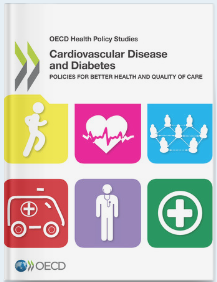
OECD Report: Cardiovascular Disease and Diabetes: Policies for Better Health and Quality of Care
19 June 2015OECD Health Policy Studies, 17 June, 2015
Fewer people are dying from stroke and heart attacks than before, but rising levels of obesity and diabetes, particularly among younger people, are going to push mortality rates higher, according to a new OECD report. The report says that advances in the prevention and treatment of cardiovascular diseases have led to a 60 per cent drop in mortality rates over the past 50 years in the OECD.
But cardiovascular disease (CVD) remains the leading cause of death in OECD countries and obesity and diabetes rates are rising which means more people will be at risk of CVD: approximately 85 million people have diabetes in OECD countries, representing around 7% of people aged 20-79 years old. That number is projected to reach 108 million by 2030, a 27% increase, and meaning a further 23 million patients with higher health care needs and greater risk of complications. Obesity rates are also rising in most countries, affecting one in five people in the OECD. The likelihood of dying from a stroke or heart attack varies widely: from less than 200 per 100,000 people in Japan, France, Korea and Israel each year to over 500 in Central and Eastern Europe countries, including Slovak Republic, Hungary, Estonia and Czech Republic. Many countries are still a long way from making the necessary reforms in their health systems to deliver the necessary quality of care needed to improve CVD outcomes.
Among the report’s recommendations are that countries should:
- Do more to promote healthier lifestyles to reduce CVD mortality rates. Anti-smoking policies have been shown to be effective, as have initiatives to reduce salt consumption and combat obesity.
- Ensure primary care is financially accessible to everyone and the gap between recommended care and care provided in practice is closed.
- Improve accountability and transparency of primary care performance.
- Establish a national framework to improve quality of acute care and set national standards for the measurement and continuous quality improvement of emergency services and care provided in hospitals to improve quality and reduce regional variations within countries.
- Ensure reforms involve every single aspect of the health system, from policies and prevention to primary care, emergency care, acute care and rehabilitation, as the complexity of treating CVD and diabetes means that the chain of care is only as strong as its weakest link.
Read the full report here.
